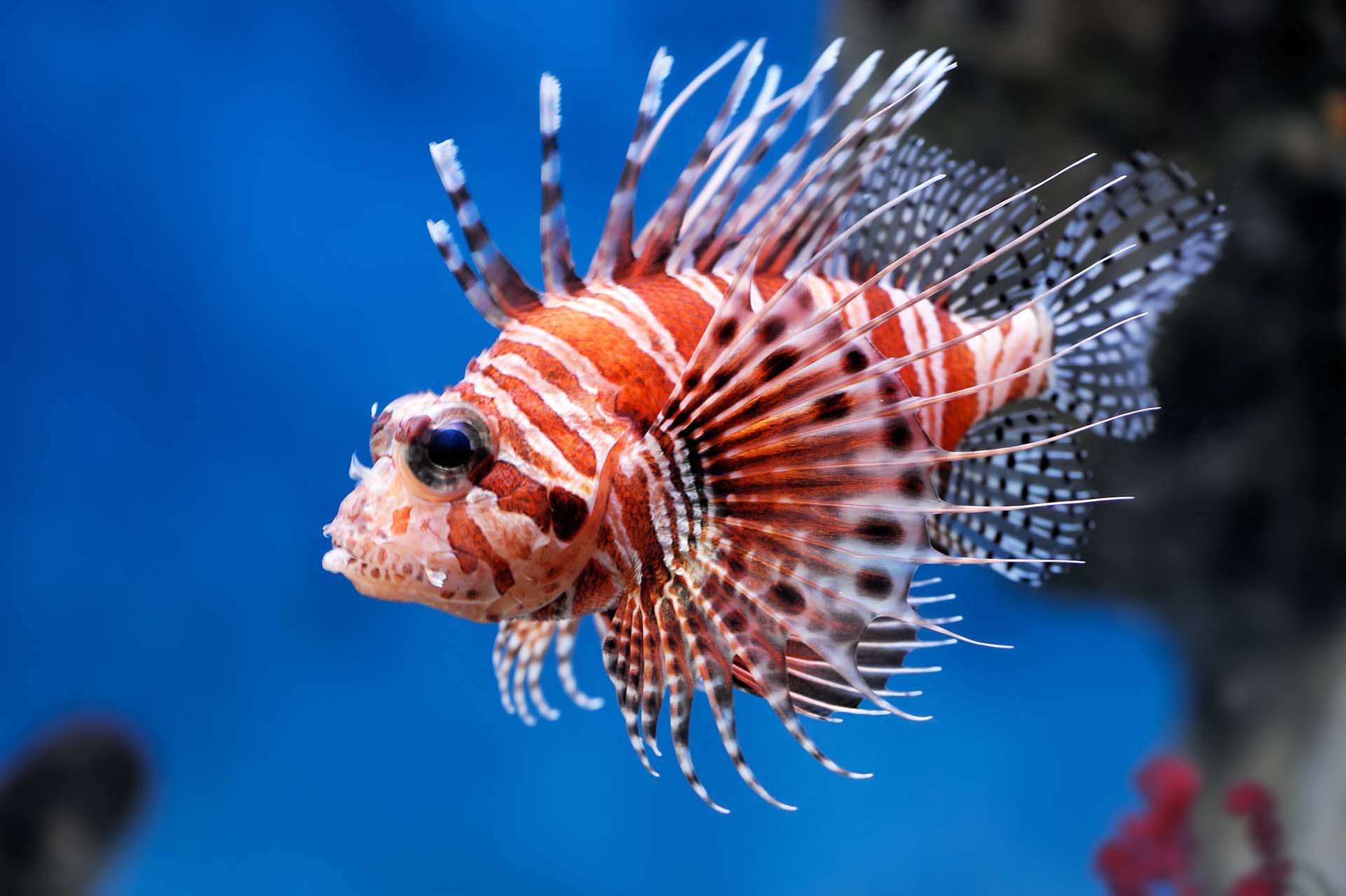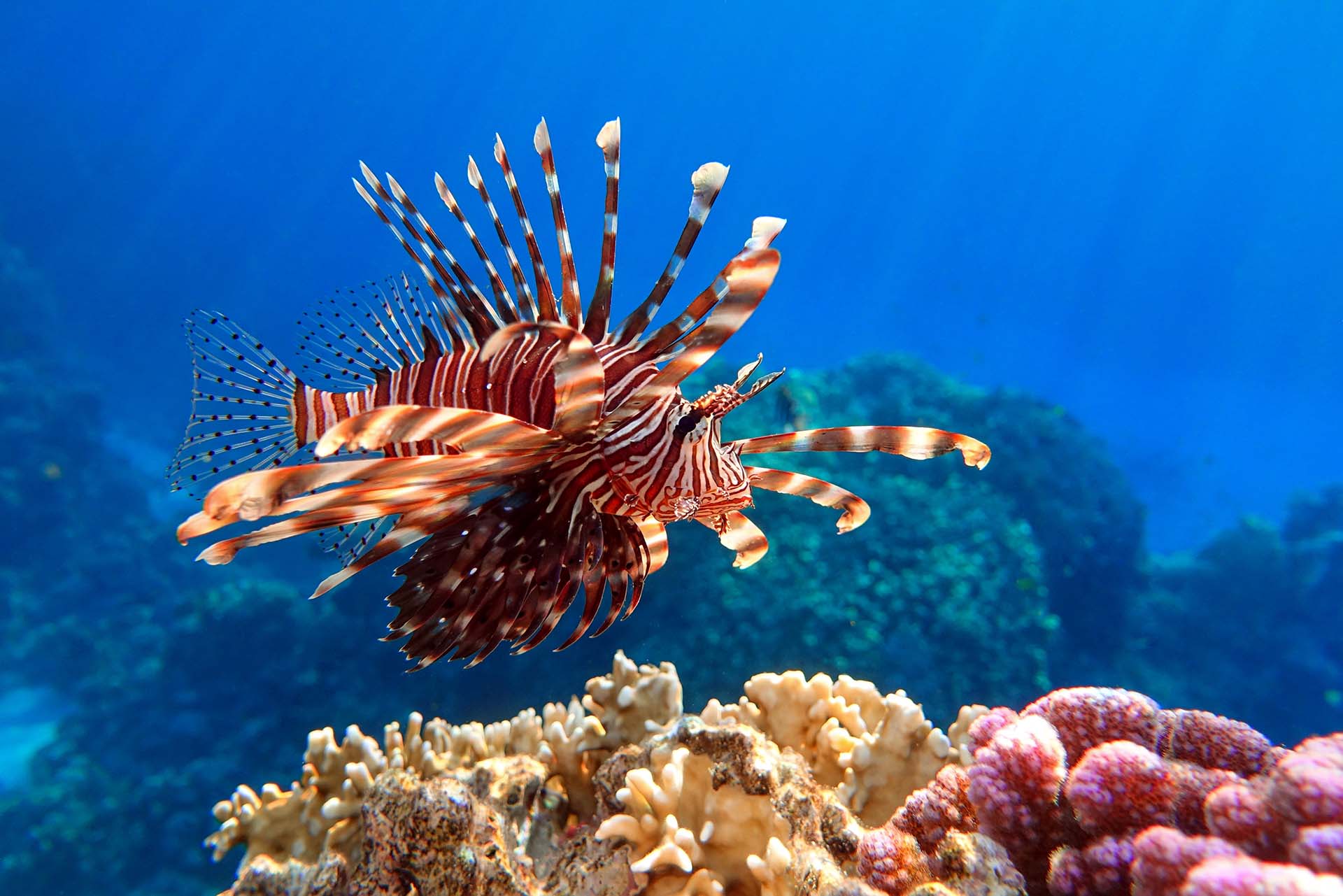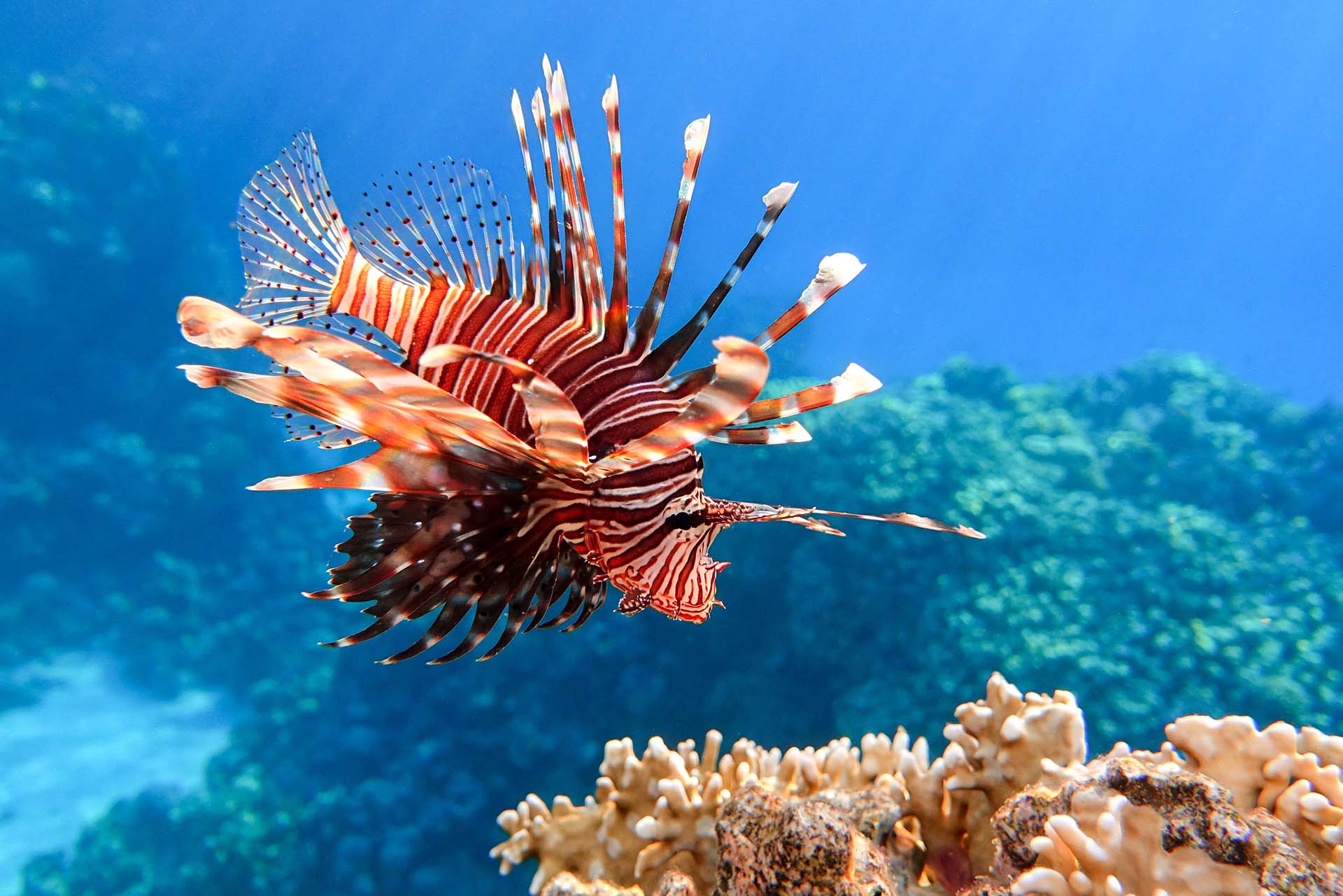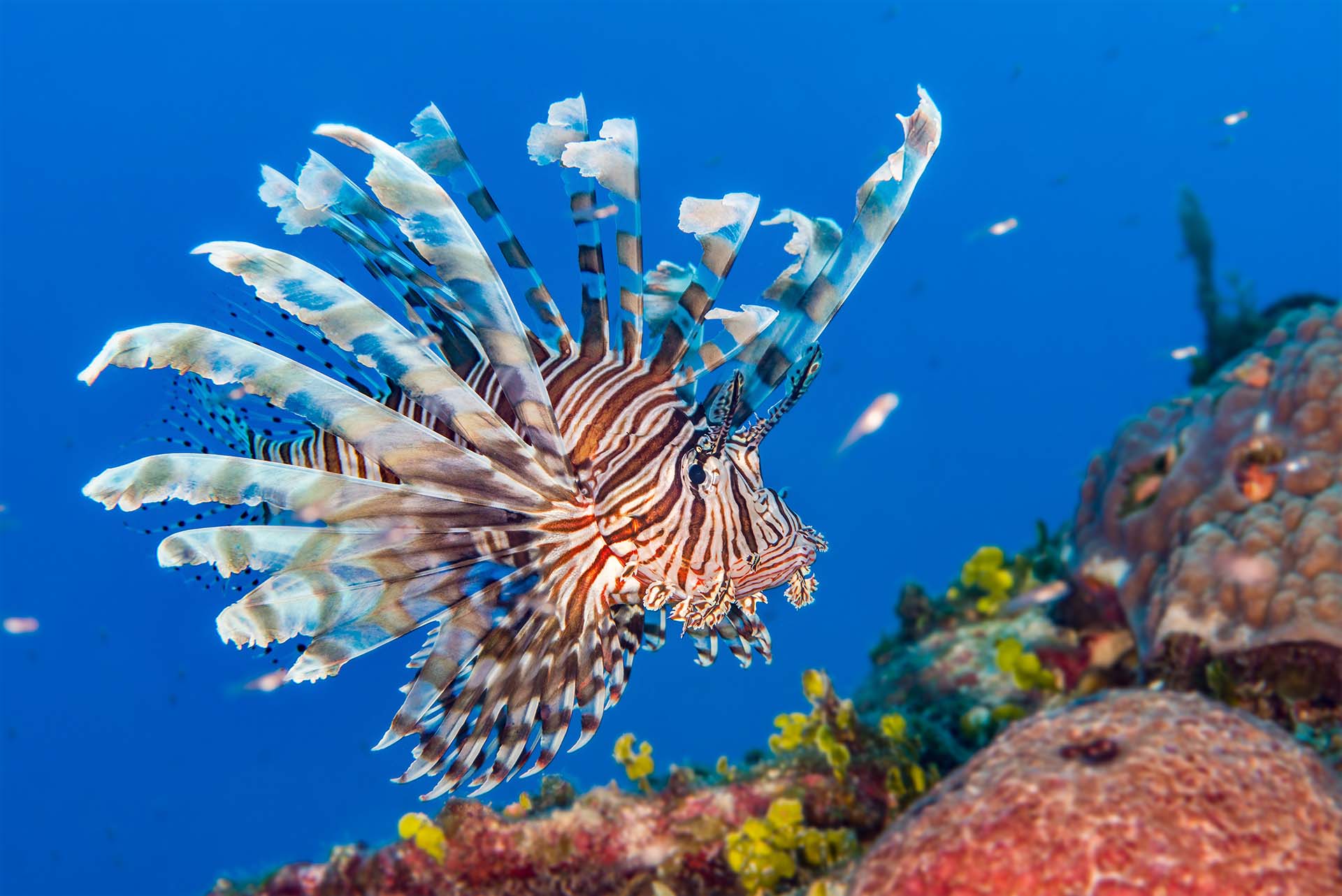With their striking appearance and venomous spines, Lionfish have captured the fascination of marine enthusiasts and researchers alike. These mesmerizing creatures are renowned for their vibrant colors, elaborate fins, and predatory prowess. In this exploration of the different types of lionfish, we delve into the fascinating world of these creatures. Uncovering facts and insights that shed light on their intriguing behaviors, geographical distribution, and the challenges they pose to ecosystems.
Understanding Lionfish – A Detailed Overview
Lionfish, belonging to the genus Pterois, are a captivating group of marine species that have captured the fascination of nautical enthusiasts, scientists, and divers worldwide. These mesmerizing creatures are native to the Indo-Pacific region. They have earned their place in the spotlight due to their unique characteristics and predatory prowess. Also, they earned the status of invasive species in various parts of the Atlantic and Caribbean oceans.
One of the key factors that makes them stand out among marine species is their striking appearance. They exhibit a cylindrical body adorned with intricate patterns of stripes and spots, serving as camouflage and a warning signal to potential predators. Their most distinctive feature, however, is the presence of long, venomous spines along their dorsal, pelvic, and anal fins. These spines, when disturbed or threatened, can deliver a painful and potentially harmful sting to those who come into contact with them.
These species are not only known for their captivating looks but also for their voracious appetite. They are carnivorous predators that feed on a wide range of marine species, including fish, crustaceans, and even small invertebrates. This dietary versatility, combined with their efficient hunting skills, has enabled them to become formidable apex predators in many marine ecosystems.
However, the nature of invasive lionfish has posed significant ecological challenges. They have been introduced to non-native environments through the aquarium trade and accidental releases. In these new habitats, they have thrived with few natural predators and have exhibited rapid population growth, disrupting the delicate balance of ecosystems. Their unchecked predation on native fish populations can lead to declines in these species and negatively impact coral reefs and other marine habitats.

Exploring the Different Types of Lionfish
This captivating group of marine species is a testament to the wondrous diversity found beneath the ocean’s surface. These remarkable creatures exhibit a wide array of features and behaviors that set them apart from one another. Each lionfish species possesses its own unique blend of colors, fin patterns, and spine arrangements, making them a subject of fascination for marine enthusiasts and scientists alike.
But their diversity extends beyond the cosmetic realm – it encompasses variations in hunting strategies, dietary preferences, and even reproductive habits. To truly appreciate the intricacies of these deep-sea wonders, it is crucial to delve into the detailed descriptions of various species and unravel preferred lionfish habitats. As well as explore the geographical distribution that shapes their presence in the world’s oceans.
The Common Lionfish (Pterois Volitans)
The Common one, scientifically known as Pterois volitans, is an enchanting creature with a distinctive appearance and intriguing characteristics. It boasts a cylindrical body adorned with vivid red, brown, and white stripes, creating a captivating mosaic-like pattern that sets it apart from other marine species.
These striking colors and elongated dorsal and pectoral fins give them an almost regal aura. However, the most remarkable feature is the presence of venomous spines along its dorsal, pelvic, and anal fins, which serve as both a defensive mechanism and a formidable hunting tool.
This species is native to the Indo-Pacific region, where it thrives in coral reefs and rocky crevices. Its choice of habitat provides ample opportunities for ambush-style hunting. They use their venomous spines to deter potential predators and to capture their prey. Primarily consisting of small fish and crustaceans. It is known for its efficiency as a predator, using stealth and precision to corner its quarry before striking with lightning-fast speed.
Despite its mesmerizing appearance and impressive hunting abilities, this type has become an invasive species in the Atlantic and Caribbean waters. This is where it poses significant ecological challenges due to its unchecked population growth and predatory impact on native marine life. Understanding the unique characteristics and habitat preferences of the Common type is crucial for mitigating its invasive presence and preserving the health of affected ecosystems.
The Devil Firefish (Pterois Miles)
The Devil Firefish, scientifically known as Pterois miles, is another captivating member of the lionfish family known for its striking appearance and unique attributes. This species exhibits a similar color palette to the Common type, with vivid red, brown, and white hues adorning its body. However, it distinguishes itself through variations in its striping pattern, adding a touch of individuality to its aesthetic charm.
Native to the western Indian Ocean and the Red Sea, the Devil Firefish has established its presence in coral reefs and rocky outcrops, much like its Common counterpart. These habitats provide ample opportunities for ambushing prey and seeking shelter from potential threats.
Like other species, the Devil Firefish relies on its venomous spines for defense and hunting. It employs stealth and patience to approach its prey before swiftly striking with its spines to immobilize and capture smaller fish and crustaceans. This hunting strategy, coupled with its vibrant appearance, makes it a dominant presence in its native environment.
While the Devil Firefish shares some similarities with the Common type. Its unique characteristics and behaviors underscore the need for a comprehensive understanding of its ecological role within the ecosystems it inhabits. As with other species, it is essential to address the challenges posed by invasive populations of Devil Firefish and develop strategies for their management and mitigation in affected regions.

What is The Ecological Impact of Lionfish?
The ecological impact represents a pressing concern in various marine ecosystems where these invasive predators have established themselves. They, native to the Indo-Pacific, have invaded Atlantic and Caribbean waters. Largely due to their introduction through the aquarium trade and accidental releases. This invasive nature has led to significant consequences for local marine life.
They have become prolific predators in their non-native environments, disrupting the balance of ecosystems. Their voracious appetite for small fish and crustaceans has led to declines in native species, including commercially important ones. The appetite also has negatively impacted coral reef communities. Moreover, their reproductive prowess, with females producing thousands of eggs frequently, exacerbates the problem. These eggs can be carried by ocean currents, further expanding their range.
Is Lionfish an Invasive Species?
Originally native to the Indo-Pacific region, the species has emerged as one of the most concerning invasive ones in Atlantic and Caribbean waters. Their invasive status can be traced back to their introduction through the aquarium trade and accidental releases. When enthusiasts released these captivating creatures into local waters, they unknowingly set in motion a chain of events that would lead to the disruption of native marine ecosystems.
Lionfish have thrived in their new environments due to a lack of natural predators, coupled with their venomous spines that deter potential threats. These factors, combined with their rapid reproduction rate, have led to skyrocketing populations. As prolific predators, they consume vast quantities of small fish and crustaceans. Causing declines in native species that are not adapted to such relentless predation. Coral reefs, in particular, have felt the impact, as lionfish disrupt the delicate balance of these ecosystems.
How to Control and Manage the Lionfish Populations?
Combatting the invasive presence has prompted various control and management initiatives, with hunting and culling at the forefront of these efforts. Divers, conservationists, and even famous fishermen have organized lionfish derbies and removal events.
These are the events where individuals actively hunt and capture the fish. Furthermore, these initiatives not only help reduce local populations but also raise awareness about the issue within the community.
Commercial and recreational types of fishing have also played a role in managing lionfish populations. By promoting the consumption as a sustainable seafood option, demand for their harvest has increased. Culinary interest has not only helped lionfish control their numbers but also contributed to reducing their negative impact on native marine life.
While these measures are making a difference on a localized scale, the long-term challenge of managing lionfish invasions requires continued research, education, and collaboration among scientists, conservationists, and the broader community. Vigilance and innovative strategies are essential to minimize the ecological impact in affected regions and protect the delicate balance of marine ecosystems.

The Quest for Ecological Harmony is Continuing
Introduced through the aquarium trade, these common fish have disrupted native marine ecosystems. As we said before, particularly on coral reefs, where their unrelenting predation has caused declines in native biodiversity. However, there is hope in the ongoing battle against the invasions. Control and management initiatives, including hunting, culling, and culinary promotion, have shown promise in reducing their populations and mitigating their impact.
Challenges persist, and the complex interactions between lionfish and native marine life emphasize the importance of continued research and cooperation. By persistently innovating and collaborating, we can work towards protecting and restoring the delicate balance of life in our oceans. While the species may have disrupted this equilibrium, human determination and dedication can help bring harmony back to the underwater world.
What Makes Lionfish Unique Among Marine Species?
They are unique among marine species due to their striking appearance, venomous spines, and ability to thrive as invasive predators in non-native environments. Their vibrant colors, elaborate fins, and potent defensive mechanisms make them stand out, while their invasive nature sets them apart as formidable predators that can disrupt local ecosystems.
How Can Divers and Fishermen Help Control Lionfish Populations?
Divers and fishermen play a crucial role in controlling the populations by actively hunting and culling these invasive species. Organized derbies, removal events, and the promotion of lionfish as a sustainable seafood option are effective methods. By participating in these activities, divers and fishermen contribute to reducing lionfish numbers and raising awareness about the issue.
Are There Any Safe Ways to Handle Lionfish?
Handling the species requires caution due to their venomous spines. Safe methods involve using appropriate fishing gear and specially designed tools like spears and containment devices to capture and handle lionfish without coming into direct contact with their spines. Proper training and safety equipment are essential for those involved in removal efforts to minimize the risk of stings and injuries.










